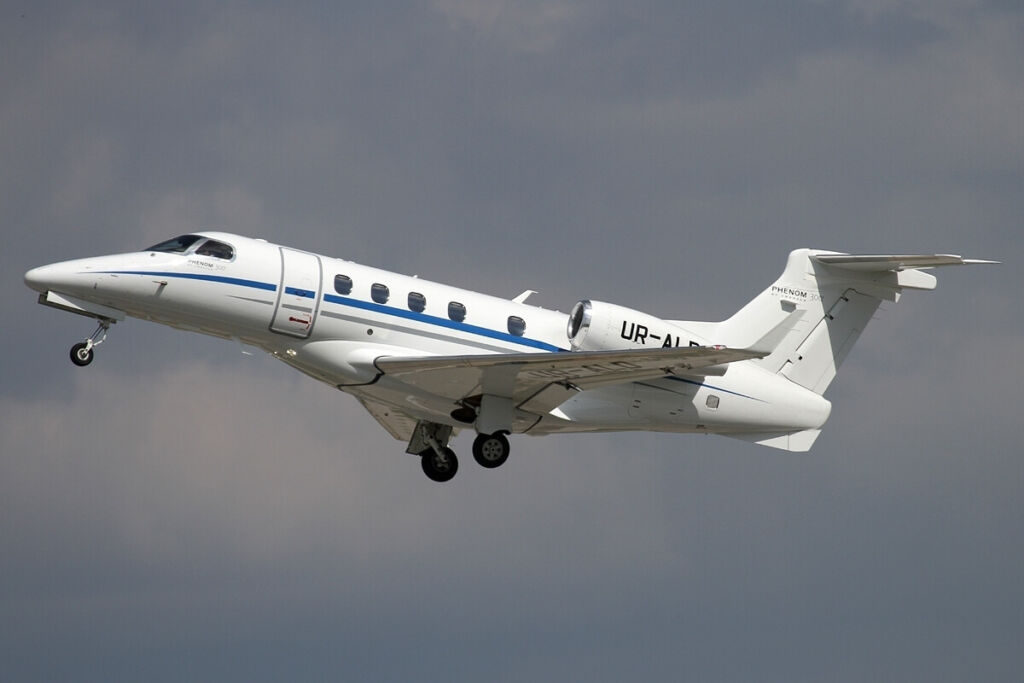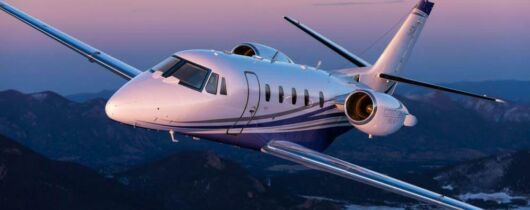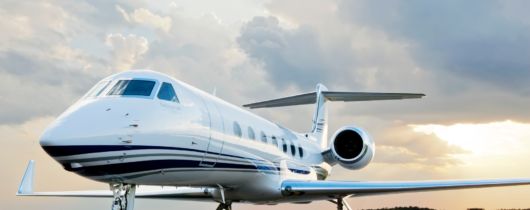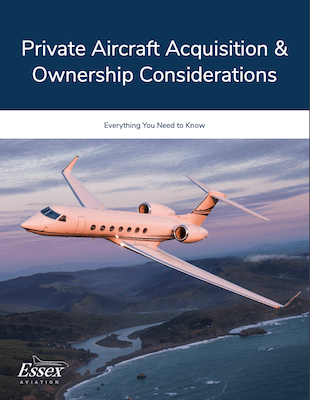
If you’ve entered the world of private aviation, you already know there is an incredibly wide range of aircraft to choose from. Whether you’re considering the merits of different manufacturers and models or attempting to choose between varying specifications such as performance, size or cabin amenities, the options can seem overwhelming.
What follows is a high level categorical breakdown of the types of private aircraft to guide you in making a more informed decision when purchasing or chartering a private jet.
Very Light Jet
The Federal Aviation Administration defines very light jets as having a maximum take-off weight of less than 12,500 pounds. The business aircraft industry often characterizes very light jets as providing comfortable seating for a maximum of four (4) passengers with full fuel and a usual range of 1,000+/- nm or less. Very light jets are popular with owners who are also licensed pilots and wish to fly their own aircraft. Most very light jet models in the skies today were introduced to the business aircraft market fairly recently.
Very light jets are especially popular for their relatively lower acquisition and operating costs. They are often the go-to choice for owners or operators who regularly travel within a limited geographical range with relatively few passengers. These aircraft stand out for their efficiency — they can be stored in small hangars, are known for their fuel efficiency and can fly at speeds and altitudes that exceed turboprop and piston model aircraft. Also, since they are fairly new to the market, the cockpits in very light jets generally feature newer technology.
The most popular very light jet models on today’s market are as follows:
*Data Source – Conklin & de Decker – Actual current pricing may vary
| Manufacturer | Model | Passenger Capacity | Range (nm) with Avg Passengers and Fuel | Speed (kts) | Cost to Acquire (New) |
| Cirrus | SF 50 Vision G2 | 3 | < 1,000 | 315 | $3.3M |
| Cessna | M2 Gen2 | 7 | < 1,000 | 404 | $6.1M |
| Embraer | Phenom 100EV | 5 | < 1,000 | 406 | $4.5M |
| Eclipse | 500 | 3 | < 600 | 371 | $1.2M |
| Honda | Elite | 5 | < 600 | 413 | $5.8M |
Light Jets
In addition to being physically larger than very light jets, light jets offer longer range and greater passenger and baggage capacity. Unlike very light jets, light jets have been available and popular for a long period of time. As a result, they are more widely available on the pre-owned market.
Besides having greater range and physical size than very light jets, the capital costs and operating costs of light jets remain attractive to many small or medium-size corporations, especially those with required destinations of 1,500 nm or less. Similar to very light jets, light jets can effectively meet both the business and personal travel needs of those who frequently make short-haul flights. Many light jets are also certified for single pilot operation, which is attractive to owners who fly themselves or wish to be a co-pilot.
Some of the most popular light jet models include:
| Manufacturer | Model | Passenger Capacity | Range (nm) With Avg Passengers and Fuel | Speed (kts) | Cost to Acquire (New) |
| Embraer | Phenom 300E | 6 | 1,811 | 464 | $10.3M |
| Pilatus | PC 24 | 6 | 1,525 | 440 | $12.2M |
| Cessna | CJ3+ | 6 | 1,410 | 415 | $10.4M |
| Cessna | CJ4 Gen2 | 8 | 1,667 | 454 | $11.8M |
*Data Source – Conklin & de Decker – Actual current pricing may vary
Mid-size Jets
As their name implies, mid-size jets are larger and have a greater range than light or very light jets. Their floorplans and amenities are especially designed for greater comfort, with larger seats and additional headroom. Due to their operating and maintenance needs, mid-size jet aircraft typically warrant professional aviation services, such as a dedicated flight department or a full-service aircraft management company.
Certain mid-size jets boast non-stop coast-to-coast range without a fuel stop, which sets them apart from the range limitations of lighter jets. The cabin of a mid-size jet is more suitable and comfortable for longer-range business or personal travel and may include amenities such as a dedicated lavatory, dining table, a partial galley and additional cabin height.
Popular mid-size jet models on the market include the following:
| Manufacturer | Model | Passenger Capacity | Range (nm) With Avg Passengers and Fuel | Speed (kts) | Cost to Acquire (New) |
| Embraer | Praetor 500 | 7 | 3,109 | 466 | $18M |
| Cessna | Citation Latitude | 9 | 2,455 | 429 | $19.7M |
| Bombardier | Challenger 3500 | 9 | 3,277 | 470 | $22M |
| Gulfstream | G280 | 8 | 3,385 | 482 | $24.5M |
*Data Source – Conklin & de Decker – Actual current pricing may vary
Large Cabin Aircraft
Besides being of greater overall size, large cabin aircraft generally have even longer available range than mid-size jets, as well as significantly enhanced cabin amenities. In terms of both comfort and capability, large cabin aircraft are better suited for certain international travel destinations than smaller aircraft.
Almost every model of large cabin aircraft can fly coast-to-coast in the U.S. — and, in some cases, from the U.S. to Europe — without a fuel stop. With longer flight durations come elevated amenities such as separate and dedicated cabin seating zones, entertainment systems with larger displays, a full-service lavatory (perhaps two), a fully functional galley, the option for worldwide internet capabilities and a more formal conference/dining table arrangement.
The following are some of the most common large cabin aircraft in the skies today:
| Manufacturer | Model | Passenger Capacity | Range (nm) With Avg Passengers and Fuel | Speed (kts) | Cost to Acquire (New) |
| Embraer | Praetor 600 | 8 | 3,745 | 466 | $21.5M |
| Gulfstream | G450 | 13 | 4,070 | 500 | $23.5M |
| Bombardier | Challenger 650 | 10 | 3,756 | 488 | $33M |
| Gulfstream | 550 | 18 | 6,583 | 488 | Pre-owned Only |
| Bombardier | Global 5500 | 12 | 5,934 | 511 | $47.5M |
| Gulfstream | G500 | 13 | 5,067 | 516 | $49.5M |
| Dassault | 2000 LXS | 8 | 3,803 | 478 | $36M |
*Data Source – Conklin & de Decker – Actual current pricing may vary
Ultra Long-range Aircraft
Separate from including privately appointed Boeing and Airbus aircraft, ultra long-range aircraft are generally top-of-the-line private aircraft offered by only a few select manufacturers. Part of the reason for this is that ultra long-range aircraft come with very specific design specifications, which few manufacturers are able to accommodate, and must undergo a series of certifications. Physically, these are greater in size than large cabin aircraft, mainly due to larger wings capable of storing the necessary amount of fuel for ultra-long distances. They also incorporate a dedicated crew rest area, which enables adding crew members to serve longer non-stop flights.
Ultra long-range aircraft models are often recently designed and manufactured, featuring the latest technology and passenger amenities. Their larger cabin size can accommodate as many as four separate seating zones — with some designed for sleeping — as well as fully accessorized forward and aft lavatories that may offer a shower option.
Remarkably, by design, some ultra long-range aircraft can still deliver on performance characteristics found in smaller business aircraft, such as the ability to access airports with shorter runways. Also, the operating costs for shorter trips of some ultra long-range aircraft are comparable to those of smaller business aircraft. Ultra long-range aircraft can not only save time by avoiding fuel stops but, when necessary, allow flight planning that avoids flying over certain parts of the world considered higher risk.
The following currently produced models are some of the most popular choices for ultra long-range jets:
| Manufacturer | Model | Passenger Capacity | Range (nm) With Avg Passengers and Fuel | Speed (kts) | Cost to acquire (New) |
| Gulfstream | 650ER | 13 | 6,985 | 516 | $70.5M |
| Bombardier | Global 6500 | 14 | 6,563 | 505 | $58M |
| Gulfstream | G600 | 13 | 6,310 | 516 | $59.5M |
| Bombardier | Global 7500 | 16 | 7,474 | 521 | $81M |
| Gulfstream | G700 | 13 | 7,150 | 516 | $78M |
| Dassault | Falcon 8X | 12 | 6,290 | 492 | $63.8M |
*Data Source – Conklin & de Decker – Actual current pricing may vary
Which Private Jet Model Is Best for Your Needs?
Of course, your specific reasons for acquiring a private jet will determine the type of aircraft you choose. But deciding on an aircraft is not just about physical or cosmetic factors — you should take travel requirements, budget, planned usage and more into careful consideration when weighing your options.
To help you plan your acquisition, we recommend consulting our comprehensive eBook on the topic. Download your own copy below and, when you’re ready to talk specifics, reach out to the Essex team to take the next step.







